Micro catchment Evidence Review










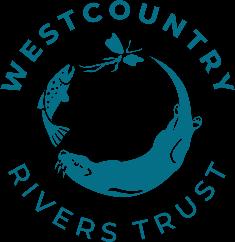
Honiton – The Gissage (939)
Exploring flood risk potential at the micro catchment scale

This document is an output from the Devon and Cornwall Soils Alliance, delivered by Westcountry Rivers Trust.
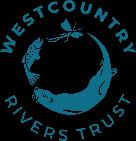
2
Executive Summary
Flood risk is a major issue for numerous communities across the South West and with the expected future impacts of climate change, as well as compounding factors such as population growth and development, it is a problem that is becoming all the more urgent. The faster a catchment reacts the greater the riskof surface water flooding and the poorer the water quality as it picks up polluting elements. A number of projects are currently underway to understand the causes of flooding and investigate potential solutions. This includes the Upstream Thinking - Rapid Response Catchments project and Devon and CornwallSoils Alliance (more info on page 6).
A mapping exercise was carried out to identify all the micro-catchments (5km2 or 10km2)above flood-risk properties in Devon and Cornwall. The idea being that Natural Flood Management (NFM) measures and engagement with the local community weremost likely to be effective at this scale and that slowing the flow benefits water quality. These micro-catchments were prioritised according to a number of factors. The catchment described in this report, The Gissage, is one of those prioritised micro-catchments.
The micro-catchment for The Gissage is 8.08km2 and highlights 168 properties potentially at risk from fluvial and surface water flooding, many of these are in Honiton. There are multiple possible contributing causes of this, including the topography, land use, and rapid runoff from the roads. The catchment is failing Water Framework Directive (WFD) regulations on both ecological and chemical status.
A rapid walkover survey wascarried out by an experienced surveyor from the Westcountry RiversTrust (WRT) to further inform potential issues and opportunities for flood riskmitigation. During the walkover, the micro-catchment displayed localised flood risk.There is opportunity to effect localised flood improvement and the ability to mitigate part of a larger flood riskdownstream (less localised) could also be considered. Additionally, the walkover presented some opportunity to deliver or contribute towards WFD (Water Framework Directive) elemental improvement.
Implementation of Natural Flood Management (NFM) measures may have the potential to mitigate some of the flood risk and simultaneously make progress towards reaching “good” WFD status for the wider Middle River Otter catchment that would ultimately benefit the local community. The NFM opportunities identified in this report include significant floodplain reconnection, runoff attenuation, and potential habitat creation surrounding existing habitats across the catchment to slow surface water flow into watercourses and enhance habitat networks. More areas of land in the north entering into an agri-environment scheme agreement could also contribute to improved soil health and biodiversity in the absence of significant habitats.
3
4 Contents Overview How this Document Works 5 Introduction 6 Micro-catchment Prioritisation 7 Why this Catchment? 8 Thematic Chapters Micro-catchment Overview 9 Priority Areas and Drivers 12 Existing Natural Assets and their Condition 23 Issues 31 Opportunities 35 Appendicesand Data Sources 50
Overview
How this Document Works
This documentisa study for causesof flooding,priorityconsiderations,and opportunitiesforNFMin the micro-catchmentforThe Gissage, covering some of the Honitonurban area in South Devon.
The study is builton multiple layersof mapped environmentalinformationand the results of the walkoversurvey. This informationhasbeenused to explore the current state of the catchmentand its environment, and then map areasfor further investigationand actionsto make improvements. This micro-catchment scaleassessmentwillbe usedto guide efforts incommunityengagement andNFM.
The study has 5 key chapters,based on the current status of the micro-catchmentand whatopportunitiesthere mightbe.
1. Micro-catchmentOverview
2. PriorityAreasand Drivers
• Flooding
• WaterQuality
• WaterQuantity
• Designated Sites
• Tourism and Recreation
3. Existing Natural Assetsand Their Condition
• Habitats
• Soils
• Crops
4. Issues
• Abstraction,Discharges,Pollution,and Runoff
• HydrologicalConnectivity
• Issues identified during Walkovers
5. Opportunities
• Existing Opportunities
• OpportunitiesIdentified during Walkovers
It isnot possible to map all aspectsof the status of the micro-catchmentwithexisting datasets,and the true state of the catchmentmay not be fully reflected inthe datasetsforvariousreasons including the age of the data,the resolution, and the level of local knowledge takeninto consideration when the data has beencollected and mapped.
Assessing the qualityand conditionof natural assetsin particularischallenging due to the level of detail required.Nonetheless,the availabledata has beenreviewed and the bestdata currently availablehasbeenused. A full set of referencescan be found on pages53-56.
5
Introduction
Flooding isa problem thatis experienced widelyacrossDevonand Cornwall,witha large portionof caseslinked to rivers(fluvial flooding as opposed to surface wateror sea).Riverwaterqualityisalso a key issue in the region,withall 381assessed rivers failing to achieve “good” statusin 2019.One importantreasonfor waterqualityfailure islinked to soil erosion.Soil erosioncan also contribute to increased fluvial flood riskdue to reduced channel capacitiesand blockages.Therefore,waterqualityand floodriskdriversare often interlinked and the solutionsto alleviate these pressures are often multifunctional.Two projectscurrentlyunderwayare aiming to tackle these issues by working withlocal communitiesto deliver small-scale,land-basedmeasures(“nature-basedsolutions”).These projectsare Devonand Cornwall SoilsAlliance (DCSA) and Upstream Thinking Rapid Response Catchments(UST-RRC).
Afteritwas found that over 40%of soilsacrossDevonand Cornwall are degraded,the collaborativeprojectof the DCSA waslaunched inJune 2019. This aimsto build the capacityand capabilityinsoilsadvice forthe projectpartnersacrossthe 2 counties to work towards restoring degraded soils. One significantbenefitof improving soil healthisgreatersurface waterinfiltrationinto the ground before itreachesand overwhelmswatercourses, thereby reducing flood riskand preventing potential pollutantsfrom entering the water.Thisalso has the potential to make considerable Water FrameworkDirective (WFD) improvementsto waterquality.
AcrossDevonand Cornwall there are hundreds of Rapid Response Catchmentsthat are characterised byquicklydraining catchmentareasunder 10km2 (and under 5km2) , where during high rainfall eventssurface flowsand overland run off overwhelm small communities(1-50propertiesin flood zone 1).Flood eventshave increased inthese types of catchmentdue to degraded soilsthatno longerhave the infiltrationcapacity,simplified drainage patternsand more variable and extreme weatherpatternsassociated witha changing climate.UST-RRCwill focusonworking withsmall communitiesinthese rapid response catchments to help them develop and delivertheirown climate resilience plansbyrestoring some of the hydrological functionalitywithinthe landscape.
The DCSA isworking in partnership with the UST-RRCprojectacrossDevonto develop 24preparatoryinvestigationsonprioritised microcatchmentsto identifylikelyareasfornature-based solutionsand NFM (Natural Flood Management) interventionswhere land ownership showsa willingnessand waterqualitycanbe improved.Communityengagementwill be criticalwhenimplementing NFMasmeasures need to be numerous and spread out across the catchmentto provide the greatestbenefits.If propertyowners and landownerscan work togetherand share perspectives, then measures canbe designed thatare agreeable to all stakeholdersinvolved.Thisalso helpsto fostera sense of community stewardship overtheir catchmentand NFM measuresthat would enhance theirlongevityand resilience.
6
Overview
Overview
Methodology
There may be opportunitieseverywhere forNFM measures and other nature-based solutionsatlow cost that also bring additional benefits to human health,biodiversity,and the aestheticsof the landscape. However,the scattered and fragmented locationsof propertiesat flood riskand the limited accessible fundsrequiresidentifying only the largestclustersof flood riskpropertieswiththe smallestupstream micro-catchmentsto deliverthe mostimpactwiththe resources available.
The processof identifying priorityareasforopportunitiesto deliver improved waterqualityand quantityforclimate change resilience wasundertaken in four steps.
1. The South Westareasof Devonand Cornwall were modelled using GIS (Geographic InformationSystems) to identifywhere opportunityareaswere located.

2. The modelled opportunityareaswere ground-truthed in theory using desk-based studies
3. The top prioritised opportunityareaswhere ground-truthed physicallyusing rapid walkoversurveys
4. Internal evidence reviews,external evidence reviews,and 2pagers summary documentswill be writtenfor24 trial investigationareas where physical interventionscan take place.
For more informationonthe first 3steps please see the appendix.
The final 24micro-catchments,including The Gissage whichisshown in red.
7
Overview
Why this Catchment?
Themicro-catchment was selectedin theGISmodelling step becauseit contains alarge numberof properties in Honiton that are potentiallyat flood risk.

The map below showswhichbuildingsoverlap withthe EA’s modelled “Flood Zone 2” area,specificallyareasatriskof flooding from rivers,as identified during the micro-catchmentmapping process.
There are 108buildingspotentiallyatriskout of 1369in the catchment,approximately7.89%of them.


The catchment’ssize of 8.08km2 givesanarea of 0.07km2 perbuilding atrisk.
The waterframeworkdirective (WFD)statusinthe widerMiddle River Otter catchmentis Poor

If property ownersare willing to workwithland owners and vice versa, then small-scale NFMmeasuresupstream in the catchmenthave the potential to benefita large numberof propertiesand improve water quality.

8
Micro-catchment Overview



Topography



The micro-catchment covers the south of the urban area of the town of Honiton in the north as well as several farms, and is intersected in Honiton by the High Street and the railway line. The micro-catchment forms the watershed for the The Gissage, and its tributary the Glen Brook, that flows northwards through the catchment and Honiton where it eventually joins the main River Otter on the north side of the A30 dual carriageway just outside of the catchment outlet. The total river length present in the catchment is approximately 21.6km. Overall, the micro-catchment falls within the Honiton County Parish and is administered by Honiton Town Council.
The map on the right shows the steepness of slopes. The Gissage runs along the bottom of a valley surrounded on 3 sides by a plateau, separated by considerably steep slopes. Honiton sits in the narrowing end of the valley.
9
Micro-catchment Overview

Land Cover

The way the land is used has significant impacts on flood management. Land use has been mapped here using the Centre for Ecology and Hydrology’s (CEH) Land Cover Map 2019. This is a model derived from satellite imagery at 25m resolution.
The land use here is primarily improved grassland, accounting for 43% of the catchment, followed by the urban area of Honiton that covers another 18%.
Patches of broadleaved woodland are spread throughout the catchment and are either adjacent to a watercourse or on top of the plateau around the catchment edges. A coniferous woodland is present on the plateau to the southeast.
Multiple fields of neutral grassland can be find on the eastern side of The Gissage, while 2 large areas of heather can be found on the plateau to the west and southwest. Aside from one large area between these 2 heather areas, arable and horticultural land is sparse and fragmented, covering only 8% of the catchment.
It should be noted that this land cover map model is not a perfect representation of land use as it simplifies UK land cover into very broad classes.
10
Micro-catchment Overview

Land Cover
Land use observed during the catchment walkover mostly matched the land use mapped here using the Centre for Ecology and Hydrology’s (CEH) Land Cover Map 2019 above.
The ground appeared to be wet in places and of lower agricultural value; particularly in the valley bottom.

Most slopes were pasture with the occasional small field or area given to maize or corn to support dairy farming.
Pockets of tree and woodland were interspersed throughout, some of the hedgerows now supporting corridors of mature trees.
11
Headwater section looking South across the Gissage valley
Mid-catchment pasture with band of maize on hilltop in the Gissage valley
Priority Areas and Drivers
Flooding hasthe potential to negativelyaffectpeople and communities. Byconsidering boththe vulnerabilityof communitiesand the opportunitiesforland managementinterventions,actionscanbe targeted to have a positive impactoncommunitiesmostatrisk.
Flooding isone of a number of natural hazardswhichcan cause harm to people,the environmentand the economy.The primarydriverfor targeting thiscatchment isflooding.However,there are otherpriorityareasand driverswhich will be affected byNFMand candetermine the mostappropriate type of NFM forthe catchment. These are mapped inthe following pages.
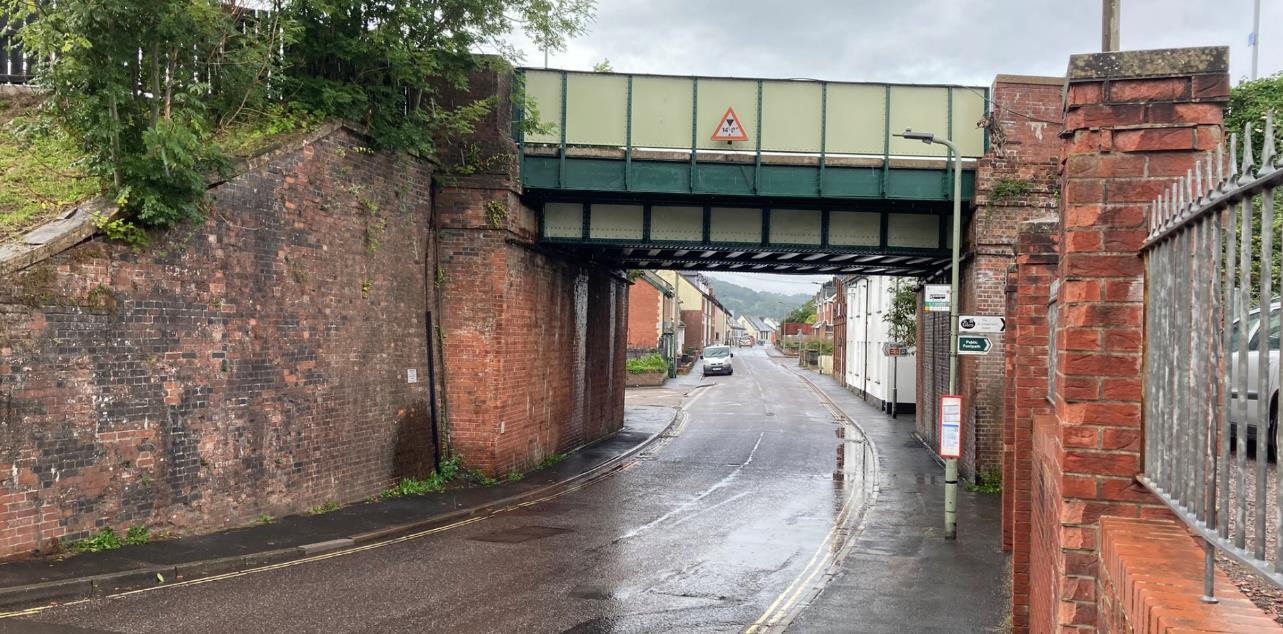
12
Priority Areas and Drivers
Flooding
The Neighbourhood Flood Vulnerability Index (NFVI) characterises vulnerability as communities likely to experience losses in wellbeing during flood events. This is based on their susceptibility, preparedness, responsiveness, and ability to recover, all without significant support from emergency services.

Roughly half of the Honiton buildings in the catchment are classed as Average in the NFVI, meaning that they are moderately vulnerable to losses in wellbeing from a flood event and generally equivalent with the UK average. However, the centre of Honiton around the railway line is classed as “Relatively High”, meaning communities are highly vulnerable to flooding compared to the rest of the UK. The rest of the catchment is classed as “relatively low”, meaning they are slightly less vulnerable.

13
Priority Areas and Drivers
Flooding
The Social Flood Risk Index (SFRI) is a geographic measure of flood disadvantage. It identifies communities who are both exposed to flood risk by living on a flood plain and who are more vulnerable to the effects of flooding, due to factors such as health, preparedness and the availability of community support. Higher numbers of people living in a flood plain coinciding with high social vulnerability result in higher index values. The map highlights neighbourhoods identified as at riskof fluvial flooding higher than the national average. Please note that this is based on flood risk from rivers and the sea, so coastal areas may not be affected by changes in land management upstream.

At present, most of the catchment within the valley is classed as “Low” in the SFRI for river and coastal flooding, and this decreases to “No exposed population” in future predicted scenarios of 2 and 4 degree temperature increases by the 2050s. However, the centre of Honiton (as identified on the previous page as Relatively High on the NFVI) increases from “Low” to “Moderate” in a 2 degree temperature increase by the 2050s scenario, and increases further still to “High” in a 4 degree increase scenario. The tops of the plateau remain at “Exposed” but the NFVI stays below the UK mean in all scenarios.

14
Priority Areas and Drivers

Flooding
When considering flooding, it is necessary to investigate records of previous flood events and combine this with modelled scenarios of what could happen, particularly in the face of the uncertainty of climate change affecting weather patterns.
The Gissage has previously flooded in 2 places in July 1968 where channel capacity was exceeded with no raised defences and there is a single building overlapping the recorded flood outline in the south, but multiple buildings overlap with the flood outline in the north. There are currently no flood defences along The Gissage in the southern flood outline. In Honiton itself, but there are a series of contiguous artificial walls, embankments, and natural high grounds along the The Gissage on both sides in the northern flood outline. These continue further up the watercourse and end shortly before it reaches the River Otter. These are owned by a mix of private individuals and the Environment Agency. All were previously inspected in May 2021 and their next inspection is due in February or March 2023.
The EA’s modelled fluvial Flood Zone 2 dataset show areas predicted to flood from rivers in a storm event so severe it is likely to occur only once every 1000 years. There are 108 properties in flood zone 2 within The Gissage. This is also known as a 0.1% Annual Exceedance Probability. Flood Zone 2 was used to identify buildings potentially at flood risk as shown previously on page 8. Here, this extends the entire length of The Gissage and its floodplain closely matches the recorded flood outlines.
The EA’s Risk of Flooding from Surface Water (RoFSW) dataset shows the extent of flooding caused by rainwater flowing across the ground towards the nearest water course in a 1 in 1000 year storm event. There are 122 properties at Risk of Flooding from Surface Water. This overlaps frequently with Flood Zone 2, but also shows depressions in the ground where surface water will accumulate. It is the only modelled risk of flooding around the smaller watercourses that feed into The Gissage. Furthermore, it identifies several depressions on the southeast top of the plateau and an area in Honiton south and adjacent to the railway line that is only at riskof flooding from surface water.

15
Priority Areas and Drivers
Flooding
The upstream rural partof the catchment appears to have a floodplain that is connected to the river and experiences wetting events. This would suggest the modelling is correct and there is flooding in times of high water.
The flooding pinch-point in the rural area appears to be the road bridge which has been repaired in the past and reinforced to mange throughput of water.
The majority of the Gissage surface water from upstream passes this point and so may present an opportunity to hold back water.
The town would appear to be at risk from large volumes of surface water as the valley, slopes, and impermeable surfaces such as roads are all very steep.

Key infrastructure such as the hospital and railway station don’t have problems with flooding towards the Eastern side off the town, further away from the Gissage, although they are elevated and still experience a lot of surface water flowing paston hard surfaces.
The Gissage watercourse is heavily channelised through Honiton although the extent of historic flooding wasn’t determined at the time of survey.
Surface water runoff and standing water was reported as a problem, as well as observed when a mobility vehicle on the pavement was soaked by a passing vehicle on the road.

16
Picture taken from the road bridge acting as the pinchpoint for ~2/3 of the catchment surface flow.
Steep surrounding topography, impermeable surfaces and rapid runoff can lead to localised flooding risk.
Priority Areas and Drivers
Flooding
The parish council does have a flooding plan which falls under the Town Emergency Response Group plan (TERG).
The TERG is comprised of town councillors and may include other key members of the community. The main body of the plan is contacting appropriate emergency services and people within the town. The National Flood Forum could be used to further identify any groups and to provide support.
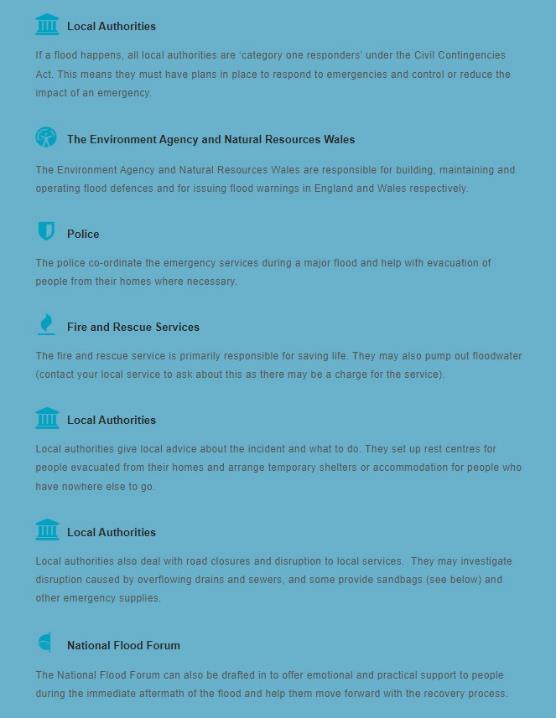
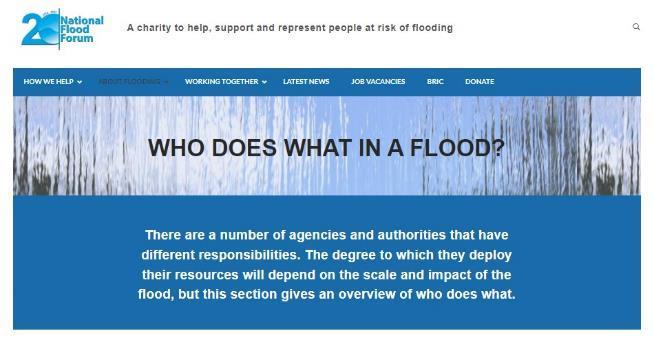
Just upstream of Honiton with The Gissage flowing through it, there is the Honiton Bottom Community Nature Reserve.

17
Priority Areas and Drivers

Water Quality
Clean and plentiful water is vital for a huge variety of our activities, and for supporting healthy ecosystems. Good water quality supports an efficient water supply, healthy natural habitats and cultural ecosystem services. A plentiful water supply is important for drinking water and household use, irrigation, industrial use and for maintaining habitats. Water quality is a key underpinning for the Water Framework Directive.
There are no Water Framework Directive monitoring sites, priority wetlands, or aquatic habitats in the catchment. The southern edge of the catchment however borders the Branscombe Nitrate Vulnerable Zone (NVZ) designated for Ground Water, also containing a historic landfill site just outside of the catchment boundary.
For more information on water quality go to slide 26.

18
Priority Areas and Drivers

Water Quantity and Drought Risk

The amount of water available for abstraction is an indicator of how much drinking water is available for people. The catchment sits within an area not currently available for licensed water abstraction (left map) but is bordered to the east and south by areas where water is available for licensed abstraction. In the context of NFM, it is also necessary to consider water availability for plants and wildlife. Drought can cause vegetation to die back, leaving bare soil exposed and more vulnerable to erosion and runoff when it eventually rains. The Vegetation Health Index (VHI) uses satellite data to combine temperature and vegetation condition to characterise vegetation health. Areas are scored between 0 and 1 with lower values indicating low drought risk to plant health and higher values indicating higher risk. Mostof the catchment is ranked relatively low at 0.35 on the VHI (right map), indicating low risk to plant life from drought stress, and the southern edge is ranked even lower at 0.295.

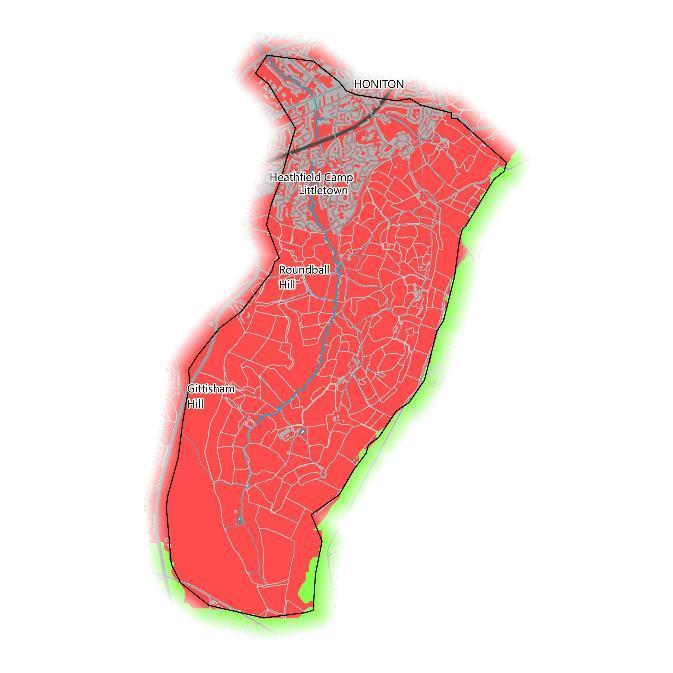
19
Priority Areas and Drivers
Designated Sites
Designated habitat sites, from small local nature reserves all the way up to large national parks, need to be protected for the wealth of benefits they provide to people and the environment, including already providing some degree of NFM. A site being designated can be an indicator of habitat health.

The majority of the catchment, aside form the urban area of Honiton, falls within the EastDevon AONB. Just outside the southern tip of the catchment boundary is Knapp Copse Local Nature Reserve. Aside from this, there are no other designated sites for habitats present.
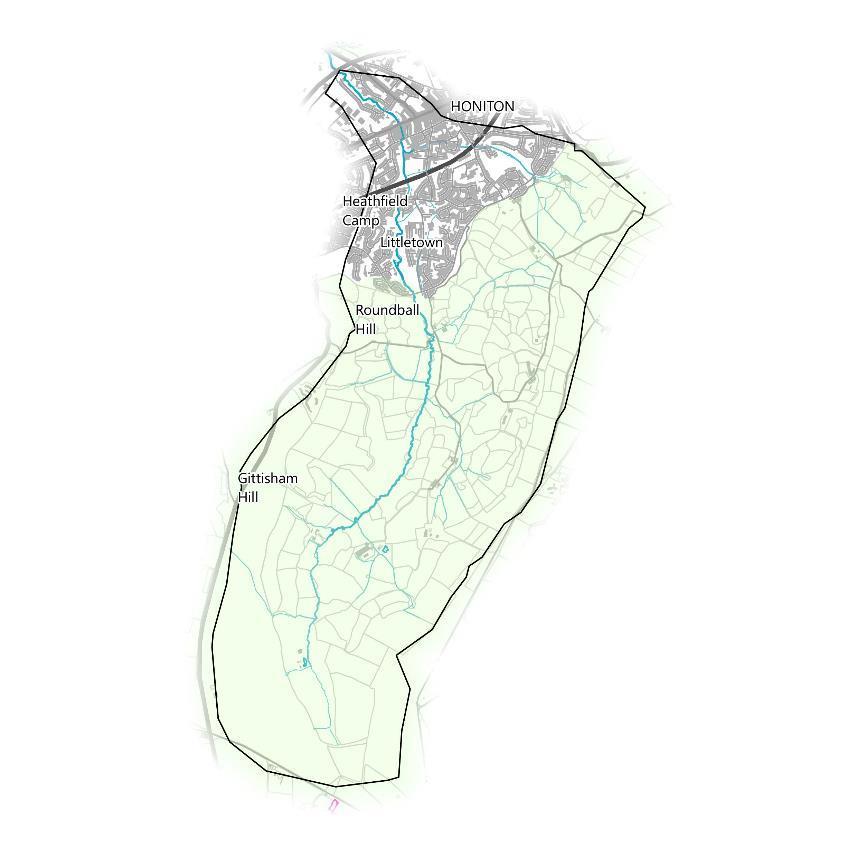
20
Priority Areas and Drivers
Air Quality
Clean air is important for people’s health and for healthy ecosystems. Air quality is the term used to describe the levels of pollution in the air. When air quality is poor, pollutants in the air may be hazardous to people, particularly those with lung or heart conditions. In the past, the main air pollution problem was smoke and sulphur dioxide from fossil fuels such as coal. Now, the major threat to clean air is from traffic emissions. Petrol and diesel motor vehicles emit a variety of pollutants, principally carbon monoxide (CO), oxides of nitrogen (NOx), volatile organic compounds (VOCs) and particulate matter (PMx).
A growing body of researchsuggested that smaller particles, in particular PM less than 2.5μm in diameter (PM2.5), is a metric for air pollution which is closely associated with the adverse health effects of poor air quality. Therefore, this section will use data relating to PM2.5 where relevant.

Improvements to the soil and surrounding environment have the potential to also deliver improvements to air quality through natural filtering processes.
The Honiton area has a relatively high concentration of air particulate matter of 7.67PM2.5 from emissions, but this falls in the centre and south of the catchment to the lowest value of 6.56PM2.5, possibly due to the sparse roads and lack of proximity to urban areas.
It is important to note that the High Street running through Honiton is an Air Quality Management Area.
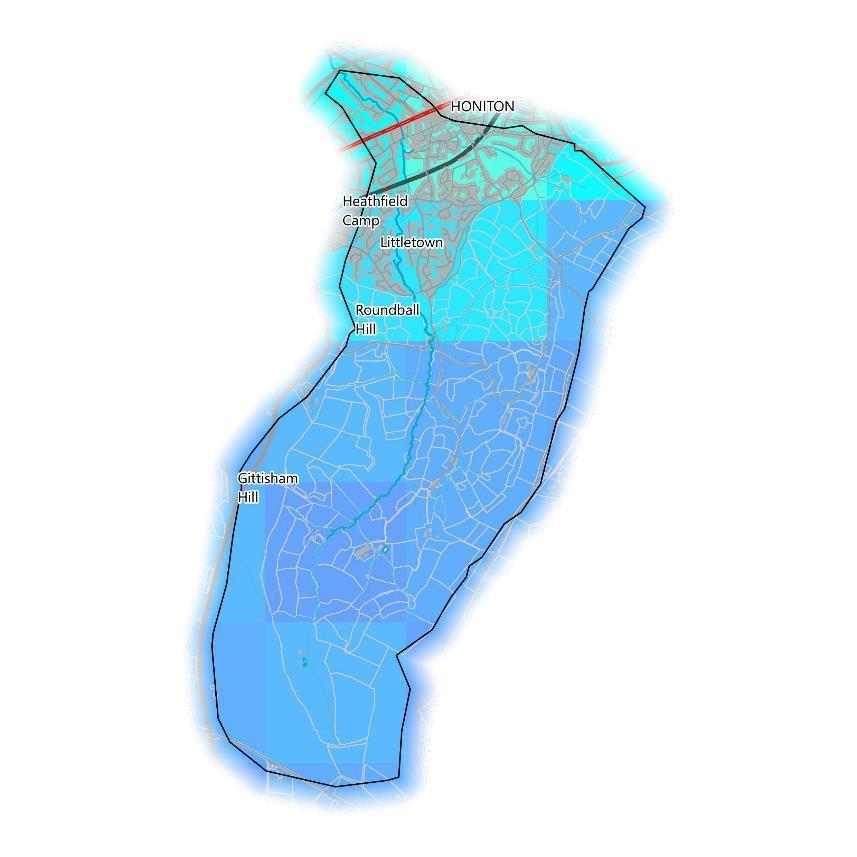
21
Priority Areas and Drivers
Tourism and Recreation


Areas and features important for tourism and recreation may also be at flood risk and it is necessary to protect them for a healthy society and environment.
The catchment exhibits several greenspaces in the north in Honiton, 8 of which are play spaces. The large greenspace north of the railway line at the confluence of The Gissage and the Glen Brook contains a playing field and a bowling green belonging to Honiton Bowling Club. Another playing field can be found south of the railway line with a small section adjacent to The Gissage. To the east on the edge of the urban area are religious grounds belonging to St Michael And All Angels Church. The large greenspace on the eastern edge of the catchment is a golf course on top of the plateau belonging to Honiton Golf Club.
A network of Public Rights of Way (PRoW) run through Honiton, one of which connects the religious grounds to the golf course. Another PRoW intersects the southeastern tip of the catchment.
The southwestern top of the plateau, identified in the land cover map as both heather and arable, is Countryside Right of Way (CRoW) Access Land.

22
Existing Natural Assets and their Condition
Biodiversity,the varietyof life of earth,is valuable initsown right. Italso supports recreation,food,flood protection and climateregulation. This sectionwill predominantlyexplore whathabitatsand othernatural assetsare presentin the catchmentthat will already be contributing to NFM and could be improved withfurther NFM measures.Water, soilsand crops are natural assets in themselvesand will also be investigated.

23
Existing Natural Assets and their Condition
Habitats and their Condition

The natural assets mapped below are habitats which have the potential to support thriving plants and wildlife. Thriving vegetation is very valuable for NFM as it roughens the ground, thereby slowing down surface water flow, meaning water courses are less likely to be overwhelmed in a storm. In addition, plant roots provide structural support for the soil and prevent surface water washing soil into water courses.
Where the assets are present the landscape is likely to be contributing to the provision of habitats, biodiversity and even NFM. Where assets are absent there may be a lack of habitats which contribute to or support thriving plants and wildlife. Assets may still be present however in the form of crops and soils which are mapped in the following pages.
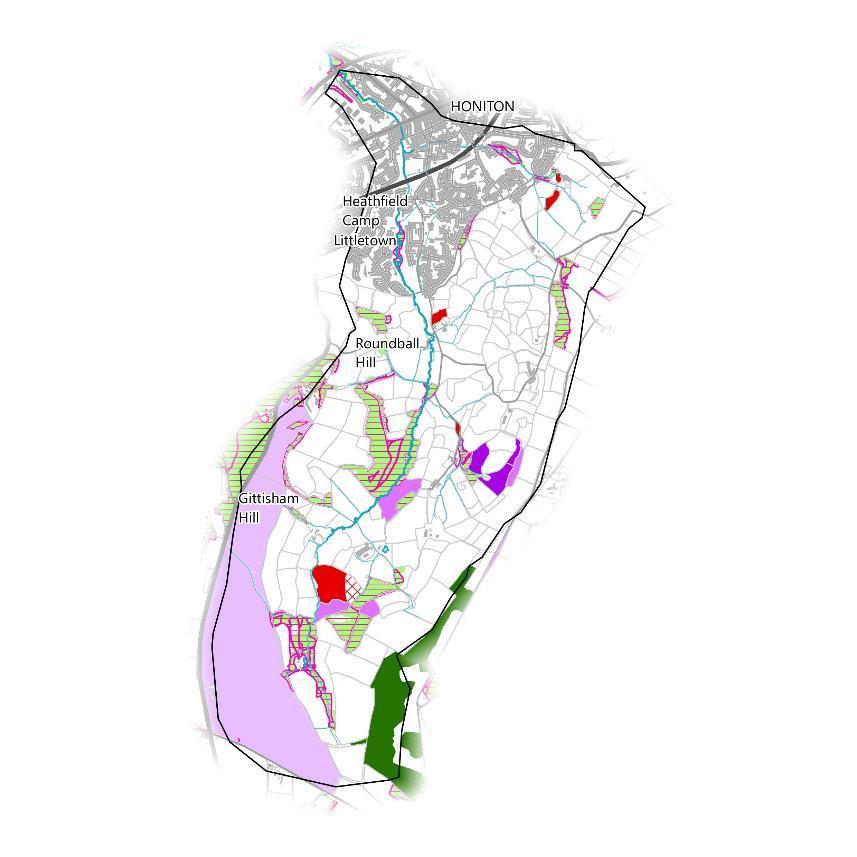
Multiple patches of broadleaved woodland are scattered in the catchment, particularly in the centre and south, adjacent to the Gissage and Glen Brook. Much of these patches are deciduous woodland priority habitats. Coniferous woodlands can be found in the southeast on the plateau.
The CRoW Access Land on the southwest edge of the plateau is lowland heather. Patches of semi-improved grassland are present in the valley bottom adjacent to the broadleaved woodland and 3 fields of purple moor grass and rush pastures. There are 5 traditional orchards, with the largest adjacent to The Gissage close to its source.

24
Existing Natural Assets and their Condition
Water Framework Directive
It is important to determine the current condition of water quality. Poor water quality can be detrimental to people, wildlife, and may cause other negative effects during a flood event. Good water quality should always be protected. A key set of evidence used to assess the water quality in a catchment is the Water Framework Directive (WFD). The status of a waterbody is measured using a series of parameters and is recorded on the scale: high; good; moderate; poor; bad (with moderate and worse being regarded as a failure).

The catchment sits at the bottom of the Middle River Otter WFD-assessed catchment, accounting for 44% of its area, and The Gissage is partof the assessed watercourses within it.
The Middle River Otter is overall classed as Poor meaning it is failing WFD regulations. It is currently failing on both ecological and chemical status. In 2019, 100% of waterbodies in the UK failed on chemical status after the EA included monitoring “mercury and its compounds” and “Polybrominated diphenyl ethers (PBDE)” into its water quality monitoring methodology.

25
Existing Natural Assets and their Condition
Water Framework Directive
The Middle River Otter is classed as Moderate for Phosphate, and Poor for Fish, Macrophytes, and Phytobenthos. Despite scoring as Good or High on other ecological classification items, these 3 failings mean it is overall classed as Poor and therefore failing WFD regulations on ecological grounds.
It is failing on Phosphate due to poor livestock management and sewage discharge by the water industry. It is failing for Fish due to watercourse barriers creating ecological discontinuity. It is failing for Macrophytes and Phytobenthos due to poor soil, nutrient, and livestock management.
The waterbody is classed as Good for most chemical classification items, except for the previously mentioned Mercury and its compounds and PBDEs, with the addition of Perfluorooctane Sulphonate (PFOS). It is classed as Failing for all 3. The waterbody’s overall chemical status is consequently Failing and is therefore failing WFD regulations on chemical grounds as well as ecological.
The reason for failure for PFOS is currently pending investigation.
The are over 60 metrics that the EA can use to monitor waterbody catchment statuses. For more information and a breakdown of this catchment’s status go to https://environment.data.gov.uk/catchmentplanning/WaterBody/GB108045009180

Waterbody: Middle River Otter
Waterbody ID: GB108045009180
Fish
Phosphate
Ecological Status
Macrophytesand Phytobenthos
MercuryandIts Compounds
Perfluorooctane sulphonate (PFOS)
Chemical Status
Polybrominateddiphenyl ethers (PBDEs)
26
Existing Natural Assets and their Condition
Crops
Crops can be a natural assetin themselves, providing the food we eat and storing carbon. Some crops however, could be considered natural liabilities. One such crop is maize which is planted in wide rows, leaving bare soil exposed and without structural supportfrom roots. Furthermore, it is often harvested in late-Autumn when the weather becomes wetter, meaning little to no vegetation can regrow to protect it over Winter. This leaves the soil much more susceptible to being carried away by surface water runoff. Despite this, maize can be successfully managed to grow and harvest while minimising runoff.
The Crop Map of England (CROME) dataset is derived from satellite data and generalised to hexagons. It identifies the town of Honiton and the sparse buildings as non-vegetated with the majority of the catchment classed as grassland. The clusters of trees broadly correlates with the habitats identified on page 24. Some maize is grown in isolated fields in the centre on the east side of The Gissage.
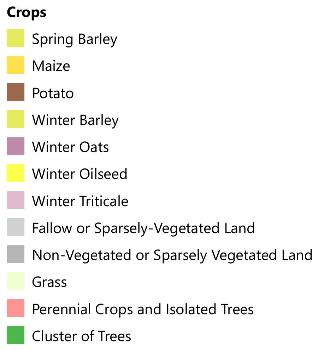
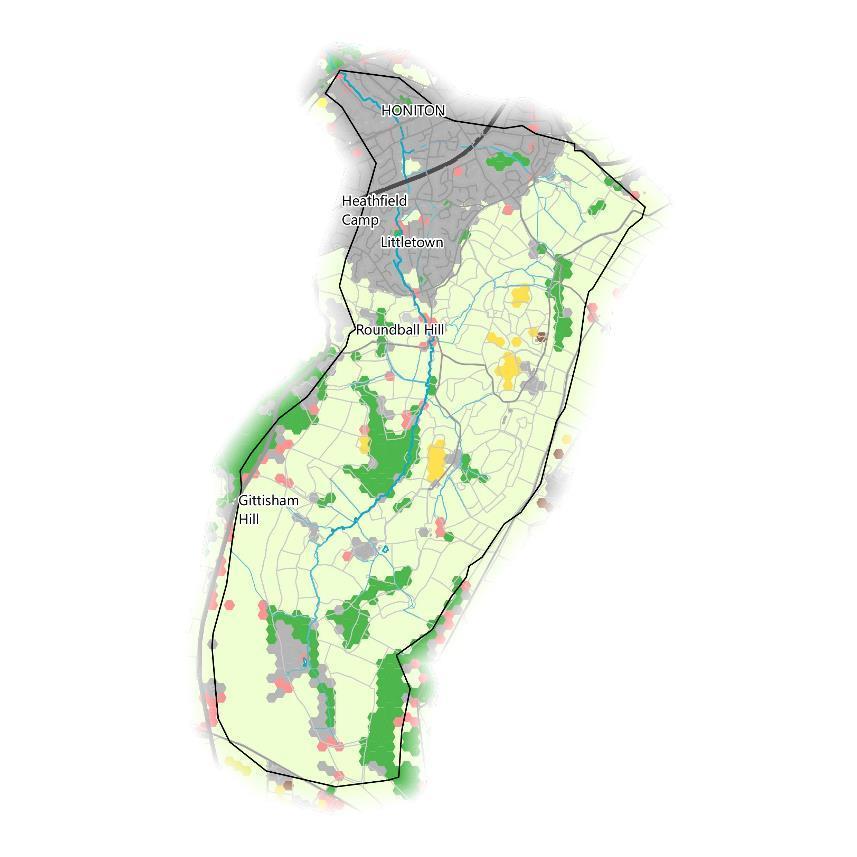
27
Existing Natural Assets and their Condition
Soils
The nature of the soil can determine how much surface water infiltrates into the ground, as well as what plants will growand where. Understanding soils is vital to providing effective NFM and improving water quality. The aim with water quality improvements is to keep the soil on the land and improve groundwater infiltration and recharge, therefore allowing a slower and more naturally filtered water route to the river.

Degraded soil structure, where the soil profile is compacted at shallow depths or capped at the surface and impermeable can lead to excessive unnatural run-off of surface water instead of percolation and infiltration. More than 60% of soils in Devon and Cornwall are naturally well-drained and should rarely become saturated. The Farming Rules for Water (FRFW) were introduced at the start of 2018 as legislation to help protect surface water quality. The regulations are designed to help manage cultivated agricultural land well, without over-management, nutrient run-off, or waste affecting surface water.
The diagram above shows good soil structure on the left and compacted soil structure on the right. In compacted soil, little surface water can infiltrate into the soil subsoil due to surface capping or compacted layers, while vegetation can be deprived of oxygen due to compression of pores that normally transport air and water (sourced from SEPA NFM Handbook).
28
Existing Natural Assets and their Condition
Soils

The NATMAP soils dataset from Cranfield University shows that the plateau following much of the edge of the catchment is comprised of the soil series Dunkeswell. The western half of the valley bottom is made of Bearsted 2, while the eastern half is Hence. Whimple 3 separates these from the Honiton urban area, which is primarily Newnham.
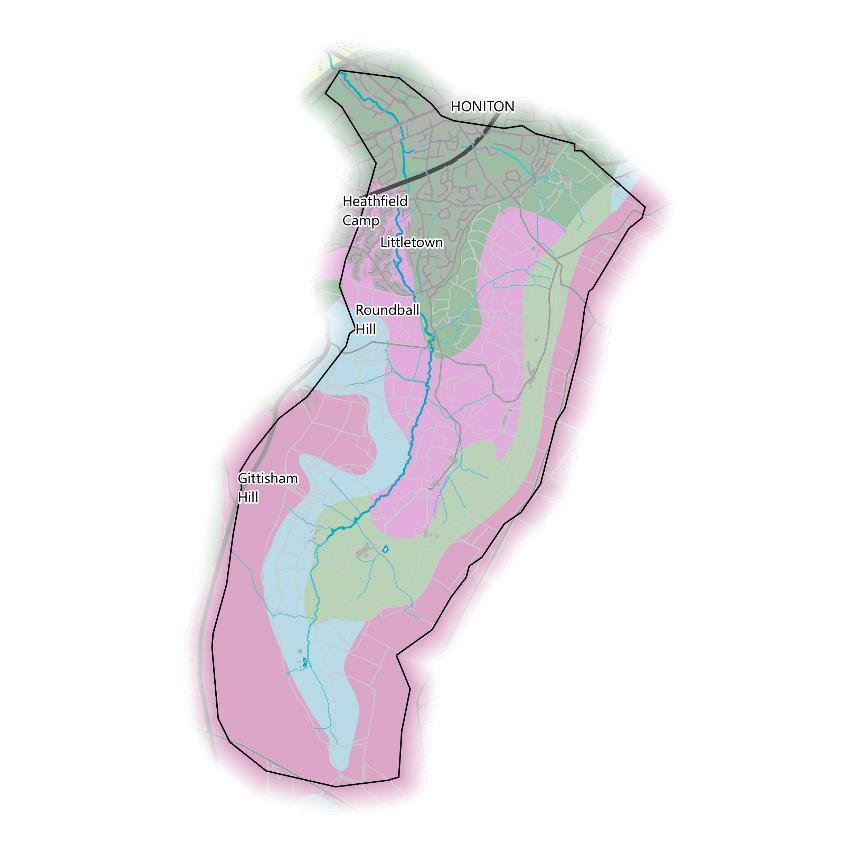
The initial walkover was not carried out by a soil expert, but there was some clay content in the soil which was conducive with wetter areas and rush growth. Soil health in the catchment wasn’t determined as further investigation will be required. The majority of land use didn’t appear to be too intensively managed which would suggest soil could be healthy, however some runoff over field surfaces could also suggest compaction in the pastwhich may not have been remedied.
Anecdotal evidence would suggest there could be some soil issues as some coloured water was observed washing down the road and drainage infrastructure in the town appeared to be blocked with fine silt.
29
The above map was created using the NATMAP vector dataset from Cranfield University in March 2022.
Existing Natural Assets and their Condition
Geology
Geological conditions impacts groundwater and soil type. When rocks are sufficiently permeable it can lead to groundwater flooding. If local flooding is caused be groundwater levels then it is unlikely that changes to land management and NFM will improve flood resilience.

According to the British Geological Survey, the plateau running along the edge of the catchment, as well as much of the valley bottom is comprised of colluvium. A thin linear band of sandstone makes up the slopes themselves down to the valley bottom. Much of the eastern side of the valley is claystone and mudstone. The Gissage’s underlying geology is riverine clay and floodplain sands and gravel. Honiton itself displays a mix of all 4 geology types.
The walkover didn’t uncover any initial suspicion of groundwater flooding and the perception is that any flood risk would originate form surface flow.
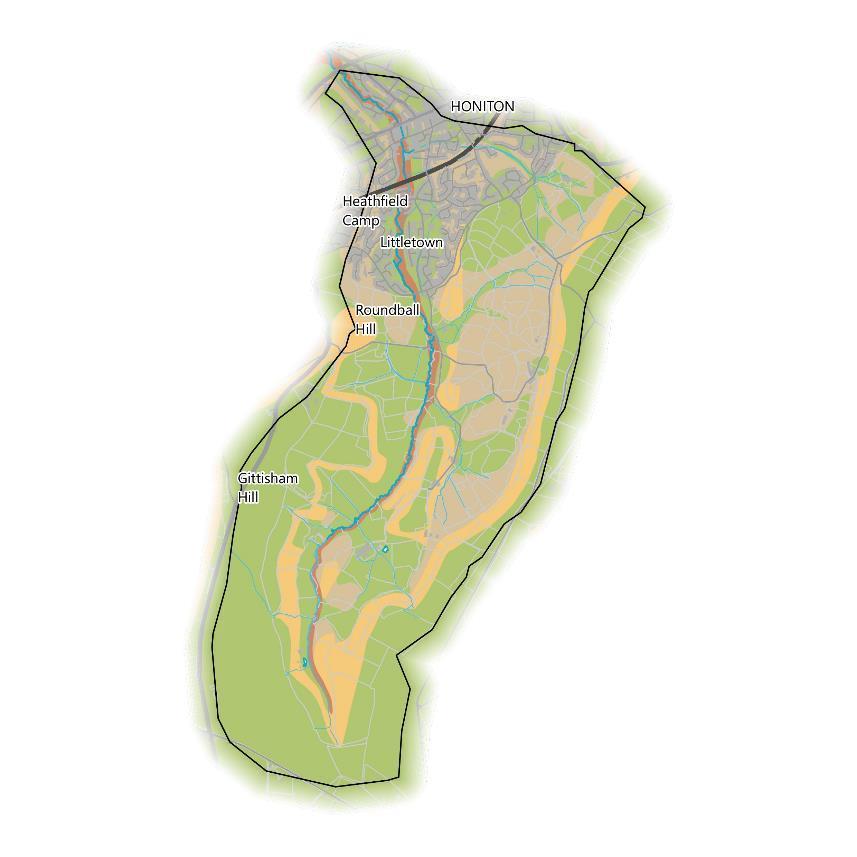
30
Issues
Multiple issues have already been mentioned and mapped that could be contributing to flood risk and WFD failures. However, there are further potential issues that may be influential which will be explored in the following pages.

31
Issues
Pollution and Abstraction
Pollution incidences themselves will directly affect water quality, but consented discharges into watercourses and chemical runoff from roads exacerbated by rainwater may also be sources of pollution.
There are no recorded pollution incidences in the catchment, but there are 7 sources of consented discharges. The southernmost is for discharging treated effluent into a soakaway. The site northeast of this is for discharging treated effluent into the River Otter. The eastern consented discharge is for discharging final treated effluent into ground water via a reedbed.

South West Water (SWW) have 4 consented discharge sites in the catchment. To the east, the Waterleat Park pumping station discharges sewage overflow into the Glen Brook. SWW have a storm tank for combined sewer overflow where The Gissage passes under the High Street and a second further downstream. Their last consented discharge is for Willowdale pumping station at the catchment outlet.
Partially overlapping the catchment, the Kings Road section of the A35 is a priority road for catchment management of runoff. This means the road itself may benefit from reduced runoff further up in the catchment.
Licensed water abstraction points may serve as sources of risk to ground water quantity and availability. However, there are no water abstraction points present in this catchment.
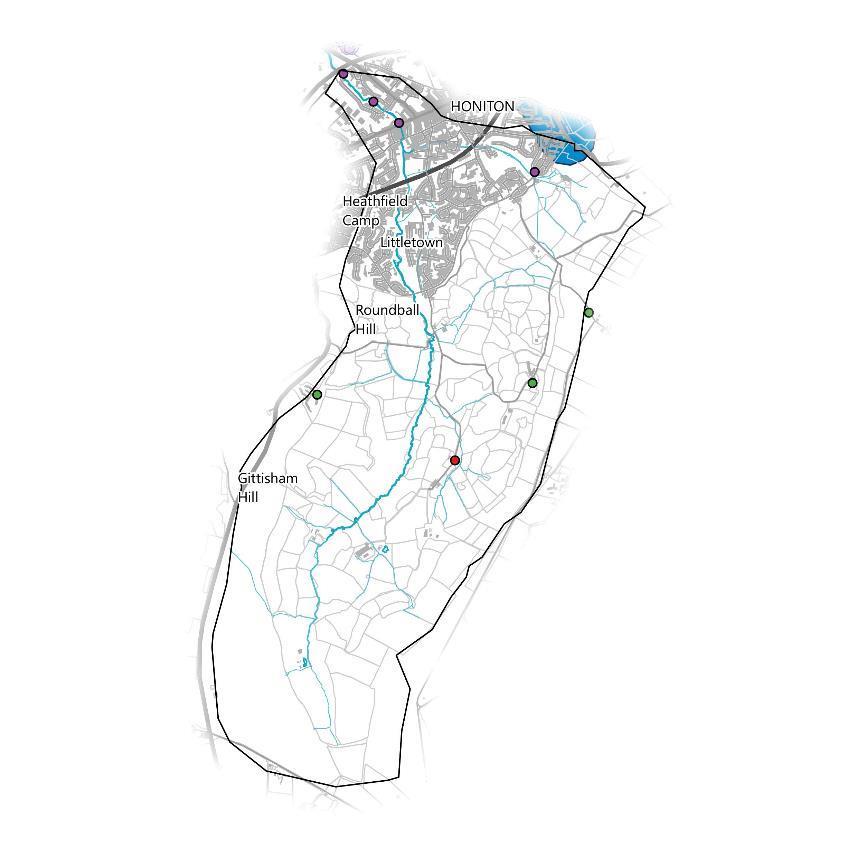
32
Issues

Hydrological Connectivity

Surface flow pathways are the routes rainwater accumulates and follows when it lands to the nearest depression or watercourse. As it flows, surface water can pick up any number of chemicals, soil, and debris and carry them into the watercourse with it. This serves to demonstrate why community engagement and working with land owners is so important, as the effects of practices upstream in the catchment cascade down via these routes. Pathways have been modelled in 2 different ways here.
The first are modelled using topographic data and software called SCIMAP (left). Only the routes with above average wetness are shown. The flat topography of floodplains skews the modelling process and the pathways in these areas should be considered unreliable.
The second method uses SCALGO Live (right). Flow routes with at least 1km2 upstream area are shown. Areas that would be flooded if 15cm of rain were to fall during a storm event are also mapped. Flooded areas are coloured by their water volume from light to dark.


33
Issues
Issues Identified During Walkover Surveys

During the walkover surveys, experienced surveyors at WRT recorded points of interest and concern, as well as potential natural flood management opportunities. The results are mapped (right) but it should be noted that the map is by no means exhaustive.

A small tributary to The Gissage shows coloured water entering the river. The colour is coming from the road runoff, not the watercourse upstream of the bridge.


This illustrates the rapid pathway that a lot of the catchment’s surface water can take to the nearest watercourse, carrying sediment and associated pollution with it.
The steep-sided catchment has a lot of fields with gateways at the most downstream extent.
This provides a rapid exit for runoff with no attenuation.
Most roads are equally steep and run straight to the river or down to the urban area of Honiton.
This map of issues was generated after one walkover survey, reflecting the situation at the time of survey. It is not exhaustive and doesn’t reflect all issues present in the catchment which will take much more effort to determine. A greater range of all the issues is present within the previous section. Any projects delivering in the catchment should undertake their own walkovers for confirmation and addition to the list.
34
Opportunities

35
Opportunities
Working With Natural Processes
There are many options to reduce flood and coastal erosion risk across the country which involve implementing measures that help to protect, restore and emulate the natural functions. These options are known as Working With Natural Processes (WWNP) or Natural Flood Management (NFM). These measures increase flood resilience by slowing the flow of water and disperse energy to keep the water at the top of the catchment or to improve groundwater infiltration and recharge, therefore allowing a slower and more naturally filtered water route to the river.
Where rapid surface water run-off has been noted there may be opportunities for WWNP to mitigate both water quality and to regulate flow. An example of some NFM interventions are given below. They are intended to slow water, store water, increase infiltration and intercept rainfall.

36
The illustration above shows various natural flood management techniques (sourced from CIRIA).
Opportunities
Working With Natural Processes

The Environment Agency have mapped potential opportunities for WWNP to reduce flood and coastal erosion risk across the country. These include opportunities for different types of woodland planting, floodplain reconnection features like restored riverside wetlands and meadows, and runoff attenuation features which aim to slow pathways of water across the land, like storage ponds or leaky barriers. Anumber of areas are also excluded from the woodland maps such as urban areas and existing woodland. These are mapped separately on page 40.
The greatest opportunity identified by these WWNP datasets for the catchment is reconnecting floodplains along much of the length of The Gissage before it reaches Honiton. Doing so should create space for wetlands to develop that would spread water out over a wider area to slow it down and dissipate before reaching the urban area. Creating areas that stay wetter for longer would also benefit biodiversity and improve water quality via natural filtration that would work towards improving the catchment’s WFD classifications.
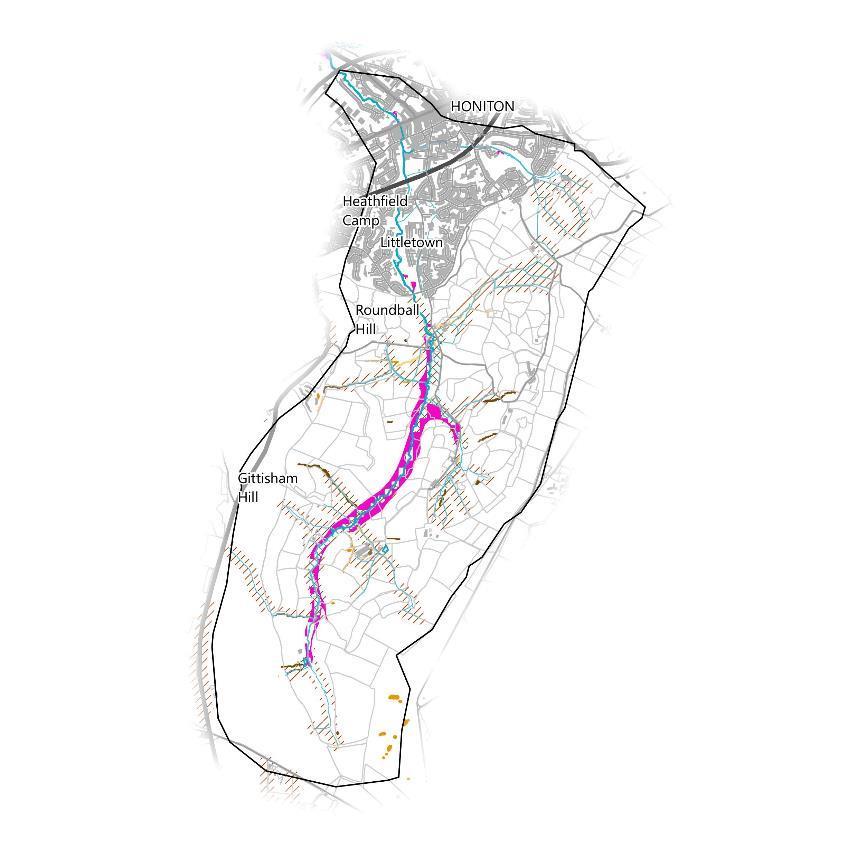
In addition, there are multiple opportunities to construct smaller scale runoff attenuation features and partially block gullies on some of the feeding tributaries that are strategically placed to slow the flow of surface water before it reaches the main water course, allowing excess water to dissipate rather than flood during a storm event.
Furthermore, there are considerable opportunities for riparian and floodplain tree planting along much of the length of all the streams in the catchment all the way downstream to Honiton, correlating largely with the possible floodplain reconnection areas.
37
Opportunities
Habitat Creation and River Restoration Projects
There may be current habitat creation and river restoration projects where opportunities exist to work together with organisations to provide simultaneous benefits to habitats, rivers, and flood resilience.
While there are no river restoration projects in the catchment, there are 6 land parcels where habitat creation is known to occur, primarily through agri-environment schemes (these are explored in the next page). The land parcels are the good quality semi-improved grassland habitats identified on page 24.
Natural England have also identified opportunities to expand on existing priority habitats to create habitat networks across the landscape (see page 24).

At the bottom of the valley and surrounding the good quality semiimproved grasslands is Network Enhancement Zone 1, defined as “Land within close proximity to the existing habitat components that are more likely to be suitable for habitat re-creation for the particular habitat. These areas are primarily based on soils but in many cases has been refined by also using other data such as hydrology, altitude and proximity to the coast.”
Elsewhere in the catchment is the Network Expansion Zone, defined as “Land within relatively close proximity to the Network Enhancement Zones that are more likely to be suitable for habitat creation for the particular habitat and identifying possible locations for connecting and linking up networks across a landscape.”
A small area on the western edge of the catchment is classed as Network Enhancement Zone 2, “Land within close proximity to the existing habitat components that are unlikely to be suitable for habitat re-creation but where other types of habitat may be created or land management may be enhanced including delivery of suitable Green Infrastructure.”

38
Opportunities
Agri-environment Schemes

Agri-environment schemes are government initiatives that aim to financially compensate farmers for providing benefits to wildlife on their land. Areas under agri-environment scheme agreements may provide opportunities simultaneously for the landowner to meet the agreement’s objectives and deliver NFM to benefit the catchment community.
The majority of the land parcels in the southern half of the valley are under both Organic Farming Scheme Agreements and Environmental Stewardship Agreements. One cluster of land parcels in the east is under an Environmental Stewardship Agreement only.
There may be opportunities for land owners in the northern half of the catchment to enter into agri-environment schemes. Habitat creation in the north in particular may be facilitated in the Habitat Enhancement and Expansion Zones as identified on page 38 if land owners were to enter into an agri-environment scheme.

39
Opportunities
Restrictive Areas
A further consideration for the targeting of NFM via soil improvement, habitat enhancements, restoration or creation is existing areas which may not be suitable for changes in land use or land management. This may be because they are already valuable sites for wildlife (e.g. designated wildlife sites), because the land use is difficult to change (e.g. urban land) or because the land is highly valuable for farming (high grade agricultural land). There may be further historic or natural heritage designations to consider.

The East Devon AONB designation (see page 20) covering all but the urban area in the catchment may provide administrative challenges, as will the woodland, heathland, traditional orchards, and other priority habitats. However, there is still the opportunity to improve these habitats further by getting more partner organisations involved in the process and even access additional sources of funding.
The WWNP woodland constraints dataset highlights any urban areas and existing woodlands (including woodlands not listed as priority habitats not shown here) where additional tree planting may be difficult. This excludes all of the catchment’s urban area. This does not mean urban tree planting is impossible, and would also provide another avenue to get the community involved the closer the planting is.


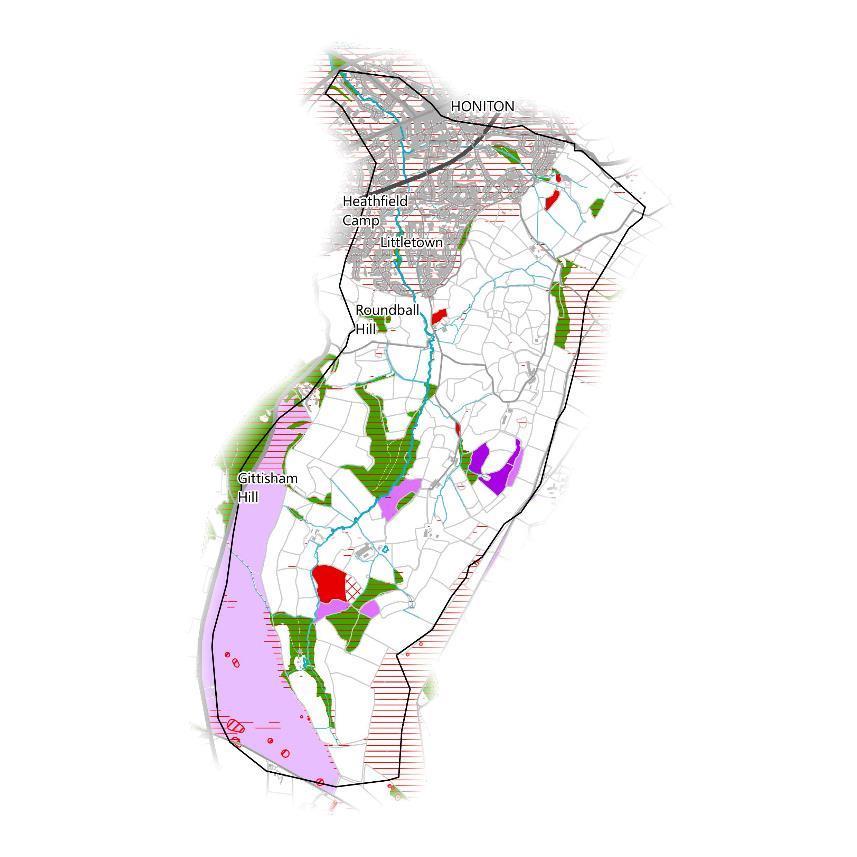
The agricultural land grade is grade 3 or 4 across the catchment which is considered average and below average respectively. A small area directly southeast of Honiton around the Glen Brook however is grade 2 which is above average. Transforming any agricultural land here into another habitat may provide challenges.
There are several scheduled monuments present on top of the plateau in the south. All are bowl barrows with some also containing an enclosure and a rink cairn. Together, these form part of a round barrow cemetery on Gittisham Hill.
40
Opportunities
Opportunities Identified During Walkover Surveys

During the walkover surveys, experienced surveyors at WRT identified opportunities for NFM measures and improvements to other key considerations mentioned. The results are mapped (right) but it should be noted that the map is by no means exhaustive.

The watercourse appears to be heavily incised with steep banks. There are multiple locations in the catchment where the river could have improved habitat and bedload to raise the bed level and reconnect the river with the floodplain in rural areas to attenuate above the urban areas.

The same applies for drainage ditches on steep slopes which could be ‘blind ditched’ to attenuate volume leaving as surface flow.
The steep-sided catchment has a lot of fields with gateways at the most downstream extent.
This provides a rapid exit for run-off with no attenuation.
Fields could be tested for soil compaction and advised on increasing infiltration.
Gateways could also be considered for relocation, or cross-drainage to attenuation to arrest rapid runoff and improve soil health.
This map of opportunities was generated after one walkover survey, reflecting the situation at the time of survey. It is not exhaustive and doesn’t reflect all opportunities present in the catchment which will take much more effort to determine. A greater range of all the opportunities is present within the following section. Engagement with landowners and stakeholders is required for a more comprehensive list of opportunities and ascertain if suggestions can be implemented in conjunction with current land use, future land use and business plans.
41
Soil Opportunities Identified During Walkover Surveys
There are some opportunities to improve flood resilience in The Gissage through changes to soil management.
The fields located around the town of Honiton, immediately upstream as defined by gravity, would benefit from soil investigations to see if the Rainfall Acceptance Potential can be improved. This would be a desirable buffer to the impermeable surfaces of the town. One or two areas would benefit from cross-slope tree planting.
In the upstream areas of the catchment where runoff has rapid routes down tracks and roads, improving soil health and water acceptance would be highly desirable to reduce the amount of runoff in the first place, but also to accept runoff if it were diverted away from the road system back in to fields.

42
Opportunities
NaturalFlood Management (NFM) or Working withNaturalProcesses (WWNP) Potential benefit in catchment Potential provider identified Locationof opportunity matches GISmaps Improve soil healthand rainfall acceptance potential ✓ N/A Sub-soil,aeration,ordecompaction ✓ N/A Contour ploughing or cross slope working ✓ N/A Change land use ✓ ✓ Some Interspersed woodland or agroforestryforinfiltration ✓ ✓ Peatland/wetland/culmrestoration ✓ ✓ ✓
Opportunities
Pathway Interruption Opportunities Identified During Walkover Surveys
There are some opportunities to improve flood resilience in the Gissage through water pathway interruption.
There are a lot of gateways situated at the lowest field point which would benefit form relocation or some form of interruption such as cross-drainage to an attenuation area.
Deflectors could be used to reconnect the river with the floodplain in areas where the land is already used to excessive water and could benefit from further attenuation features such as scrapes.


43
NaturalFlood Management (NFM) or Working withNaturalProcesses (WWNP) Potential benefit in catchment Potential provider identified Locationof opportunity matches GISmaps Cross-slope planting of treesor hedges ✓ ✓ ✓ Gatewayrelocation ✓ N/A Cross-slope buffer(beetle bankor cross-drain) ✓ ✓ Timber/stone instream deflectors ✓ ✓ ✓
Opportunities
Attenuation Opportunities Identified During Walkover Surveys
There are some opportunities to improve flood resilience in The Gissage through water attenuation on non-floodplain wetland.
Temporary ponds and farm ponds are an important way of attenuating water to improve flood resilience and to form a buffer for water quality. Ponds provide settlement and possible bioremediation for water quality if designed appropriately.
There is opportunity and willingness in the catchment for this type of intervention, and possibly multiple opportunities.

44
NaturalFlood Management (NFM) or Working withNaturalProcesses (WWNP) Potential benefit in catchment Potential provider identified Locationof opportunity matches GISmaps Attenuationpond / farm pond / wildlife pond ✓ ✓ N/A Run-off scrape or swale / temporarypond ✓ N/A Run-off bunded storage oroff-line storage ✓ N/A Blind ditching indrainage ditches ✓ N/A Headwaterdrainage management Attenuationpond / farm pond / wildlife pond ✓ ✓ N/A
Slow the Flow Opportunities Identified During Walkover Surveys
There are some opportunities to improve flood resilience in The Gissage through increasing channel and floodplain roughness to slow the flow.
Two thirds of the catchment lies above a road bridge which would appear to be a pinch-point in the catchment and have the potential to reconnect with the floodplain in multiple locations above it; thus slowing the flow past this point.
Leaky barriers would appear of limited value in such a steep catchment, but may act like blind ditches in some strategic places.
Large woody debris and floodplain reconnection could be a good opportunity in the rural area if it fits with the land manager’s business model.

45
Opportunities
NaturalFlood Management (NFM) or Working withNaturalProcesses (WWNP) Potential benefit in catchment Potential provider identified Locationof opportunity matches GISmaps Channel restoration,sinuosity N/A Large/coarse woodeddebris introduction ✓ ✓ N/A Floodplainreconnection (palaeochannelreconnection) ✓ ✓ ✓ Riparianbufferstripsor woodland (sloped) ✓ ✓ Floodplainwoodland orwet woodland ✓ ✓ Peak flow leakybarriers ✓ N/A Bed renaturalisation– armour/ gravel augmentation N/A
Engagement
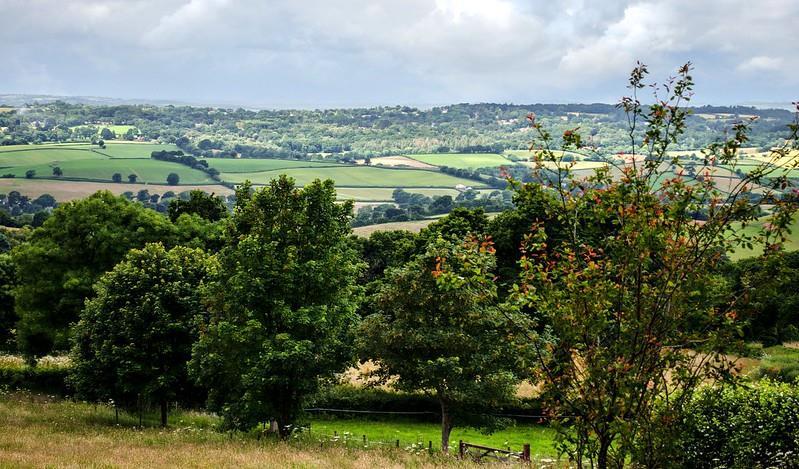
46
Engagement
Current Engagement
There are 21 landowners in the catchment. WRT has engaged with farmers managing 15.5% of the total farm area under UST. The 3 largest landowners own 63.3% of the catchment.
WRT has also engaged the catchment community in other projects.
The local community appears too already have measures to increase the climate resilience of Honiton. Details of the village’s flooding groups can be found on slide 18.
The parish council does have a flooding plan which falls under the Town Emergency Response Group plan (TERG).
The TERG is comprised of town councillors and may include other key members of the community. The main body of the plan is contacting appropriate emergency services and people within the town.
47
Engagement
Getting Involved
As well as the opportunities identified in the previous section, there may be opportunities for you to get involved as an individual.
WRT runs a Citizen Science Investigation (CSI) team of volunteers across the south west, whereby volunteers receive a testing kit and training to procure water samples from a watercourse. Westcountry CSI aims to engage people with their local environment, and produce water monitoring data that can identify pollution events quickly and target improvement work.
There is an active CSI sampling site on The Gissage on the edge of Honiton and a free site that can be taken up directly south of this. There may be the potential for more sampling sites along The Gissage and the Glen Brook in Honiton and further upstream the catchment in the south if there is suitable access to the water.
For more information about Westcountry CSI, including instructions on what’s involved and how to sign up, visit our website at wrt.org.uk/westcountry-csi
Another opportunity for you to get involved in is the Riverfly Partnership’s Anglers’ Riverfly Monitoring Initiative (ARMI). This recognises that anglers are very well placed to monitor river water quality and facilitates communication between them and their local Environment Agency contact.
There are no riverfly survey sites within the micro-catchment, but, as with CSI sites, it may be possible to start a new site if there is suitable access to the water and with communication with the Environment Agency.

For more information on ARMI, visit their website at riverflies.org/anglersriverfly-monitoring-initiative-armi

48
Summary and Next Steps
Multiple reasonsforthe possible causesand remediesforflooding inthe micro-catchmentforthe Gissage have been mapped inthisstudy, as have other factorsthat are key to considerwhen making NFM decisions. The speed atwhich this catchmentreactsto rainfall iskey to the flood risk and to the waterqualityrisk of the widerWFD waterbody.
It islikelythat a combinationof causesare at playhere contributing to there being propertiesatflood risk,including the topographyand the land use. The greatestrisk appearsto stem from rapid runoff to the roadssystem and to the watercourse withvery little interruptioninthe routes. With all the surface waterbeing confined to The Gissage through Honiton,there isonly a limited rivercapacityonce constrained and channelised inthe urban area.
It has beenestablished thatthere iswaterqualityissues through WFD failuresand problemswithsurface waterflooding,althoughthe extentwill need further investigation.Ithasalso been confirmed thata solutionexistswithin the community,through a willingnessfrom the rural community to make adjustmentsto the way the land ismanaged.
The nextsteps are to engage and empowerthe communityin the catchmentto discuss and work towardsbuilding flood resilience throughsome of the opportunitiesmapped inthe previouspages.It is imperative thatpropertyownersand landownersshare perspectivesand worktogetherto find solutionsagreeable to all sides.Mostopportunitieswill provide complementarybenefitstowardsimproving the catchment’sWFD chemical and ecological status.
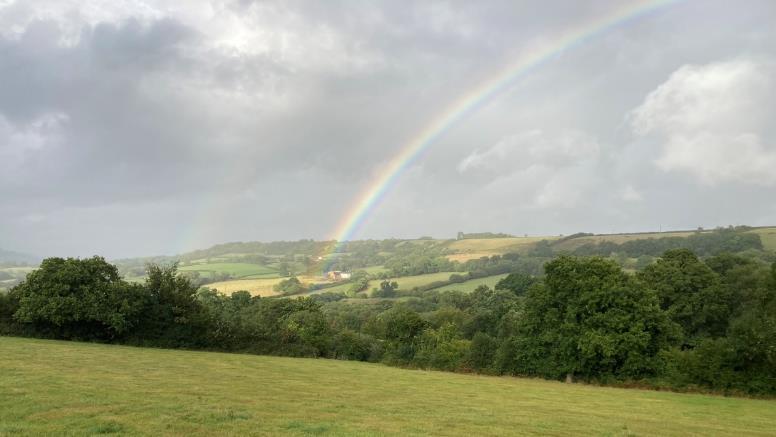
49
Appendix

50
Methodology Details
Step 1: Micro-catchment Mapping Method
The processforidentifying the highest-impacting locationsof NFMmeasures acrossDevonand Cornwall involved several stepsin a Geographic InformationSystem (GIS).The first step was to identifywatercourseswithan upstream watershed less than 10km2 and less than 5km2 in size,then to identifypropertiesadjacentto these watercoursesthat overlapped withthe EnvironmentAgency’s (EA) fluvial “Flood Zone 2”dataset.Next,pour pointswere placed onthe watercoursesin front of the furthest downstream flood riskproperties.These pourpoints were thenused to delineate the upstream micro-catchmentboundaries.A total of 1270micro-catchmentswithpropertiespotentiallyatriskwere identified across the 2counties.
For every micro-catchmentidentified,itsarea wasdividedbythe number of flood risk propertieswithinitto calculate the area perproperty atrisk foreach micro-catchment.Those withthe lowestarea perpropertyindicated higherpotential forsmall-scaleNFMmeasuresto benefitthe greatest number of flood riskproperties.
Lastly,additional factors,suchas WFD classificationsand previousWRT engagementwithfarmers,were considered alongsidethe area perproperty atflood risk toprioritise a small numberof micro-catchmentsto targetcommunityengagementand NFM delivery.
Modelling assumptionsand constraints:
➢ Due to the large geographic extent(Devonand Cornwall)and the manual elementof the mapping (bothcausing the mapping processto be time-consuming),the resolution/accuracyof some datasetsmaybe compromised.
➢ The buildingsdataset(OS VectorMap Buildings) isnotasaccurate as OS MasterMap - some propertiesare amalgamatedinto a single polygon and very small buildingsare notshown. Therefore propertiesatriskof flooding maybe underestimated.
➢ Potential flood-riskisidentifiedbyselecting building polygonsthatintersectthe flood zones;no detailed local information (e.g.drainage or defences) ormodelling hasbeenused.
➢ The spatial resolutionof the topographydata iscoarse (50m).Thisisused to calculate the upstream catchmentarea foreach communityat-risk. Therefore,some errors mayoccur (additionsoromissions) whenidentifying micro-catchments.
➢ The mapping method involvesanelementof manual validation,whichhasthe potential to be subjective and/orpossible errors.
51
Methodology Details
Step 2: Theoretical Ground Truthing
Once catchmentswere modelled and the informationtabulated to show theoretical flood risk in conjunctionwithWFD failures, a systematic approach to ground-truthing was adopted.
Catchmentsthat were perceived to have elevated water quality and water quantity risks were discussed with local land management advisors and regulators to determine if the modelled risk was likely to be correct.
Upon a theoretical, or desk-based ground-truthing,the catchmentswere then surveyed using a rapid walkover survey to observe run-off pathways and confirm if useful managed interventions could be implemented to reduce flood risk locallyand improvewater quality in the process.
Step 3: Rapid Walkover Survey
A further modelling process using SCIMAP was undertaken to identify high risk run-off pathways of the specific micro-catchmentbeingsurveyed to assist the surveyor in locating issues within a <10km2 area.
Where possible, surveyors reacted to high rainfall predictions and went out to observe the catchmentwhen the conditions were right.
Walkover surveys were undertaken noting observations about surface water run-offand taking photographs of key areas and issues. All walkovers aimed to provide:
➢ Dry or Wet weather photos,
➢ Identify stakeholder PROVIDERS where NFM can be instigated,
➢ Identify stakeholder BENEFICIARIES by property and number people,
➢ Establish opportunities in each catchmentand feasibility of action.
Georeferenced photos were taken to provide a visualoverview of issues, opportunities, and as general reference notes.
Where issues and opportunities existed, further investigation was made or attempted to establish the realistic chances of further action. This was achieved by either speaking withthe localcommunityor contacting communitygroupsor key landowners.
All 1270 micro-catchments with properties potentially at risk were identified across the 2 counties.

52
References and further information
Reference
Resourcedescription
Link
CIRIA (Slide 43)
The Construction Industry Research and Information Association’s (CIRIA) Natural Flood Management Manual (C802) (PDF)
https://www.ciria.org/Books/Free_publications/C802F.aspx
FRFW (Slide 32)
Statutory guidance for Farming Rules for Water (FRFW) (Webpages)
https://www.gov.uk/government/publications/applying-thefarming-rules-for-water/applying-the-farming-rules-for-water
SEPA NFM Handbook (Slide 32)
Handbook describing various natural flood management interventions and case studies (PDF)
https://www.sepa.org.uk/media/163560/sepa-natural-floodmanagement-handbook1.pdf
53
Mapping Data Sources
Dataset Source
AttributionStatement
Agricultural Land Classification Natural England © Natural England copyright. Contains Ordnance Survey data © Crowncopyright anddatabase right2022.
Air Quality Management Areas UKAIR
© Crown copyright and database rights licensed under Defra's PublicSectorMapping Agreementwith Ordnance Survey(licence No. 100022861) and the Land andProperty Services Department(Northern Ireland) MOU206.
Ancient Woodland Natural England © Natural England copyright. Contains Ordnance Survey data © Crowncopyright anddatabase right2022.
AONB Natural England © Natural England copyright. Contains Ordnance Survey data © Crowncopyright anddatabase right2022.
Areas Benefitting fromFlood Defences EnvironmentAgency
© EnvironmentAgency copyrightand/or database right 2018. Allrights reserved.Some features of this mapare based on digital spatial data from the Centre for Ecology & Hydrology,© NERC (CEH) © Crowncopyright anddatabase rights 2018Ordnance Survey 100024198
Bathing Water Monitoring Locations EnvironmentAgency © EnvironmentAgency copyrightand/or database right 2015. All rights reserved.
Consented Discharges
Country Parks
Countryside StewardshipScheme Agreements
NaturalEngland © Natural England copyright. Contains Ordnance Survey data © Crowncopyright anddatabase right2022.
Natural England © Natural England copyright. Contains Ordnance Survey data © Crowncopyright anddatabase right2022.
Crop Map of England Rural Payments Agency
CRoW Access Land NaturalEngland
CRoW RegisteredCommonLand
© Rural Payments Agency
© Natural England copyright. Contains Ordnance Survey data © Crowncopyright anddatabase right2022.
NaturalEngland © Natural England copyright. Contains Ordnance Survey data © Crowncopyright anddatabase right2022.
DetailedRiver Network EnvironmentAgency © EnvironmentAgency Crown copyrightand databse right 2022.
Drinking Water Safeguard Zones (Ground Water)
Drinking Water Safeguard Zones (Surface Water)
EnvironmentAgency © EnvironmentAgency and/ordatabase rights. Derivedfrom BGSdigital data under licence from British Geological Surveycopyright NERC.
EnvironmentAgency © EnvironmentAgency copyrightand/or database right.All rights reserved. Derived fromBGS digitaldata underlicence fromBritish Geological Survey ©NERC. Derived fromCentre of Ecology andHydrology data ©CEH
Energy Crop Scheme Agreements NaturalEngland © Natural England copyright. Contains Ordnance Survey data © Crowncopyright anddatabase right2022.
Environmental Stewardship Scheme Agreements
Flood Defences
Flood Zone 2
Natural England © Natural England copyright. Contains Ordnance Survey data © Crowncopyright anddatabase right2022.
EnvironmentAgency © EnvironmentAgency copyrightand/or database right 2020. Allrights reserved.
EnvironmentAgency
© EnvironmentAgency copyrightand/or database right 2018. All rights reserved.Some features of this map are basedon digital spatial data from the Centre for Ecology & Hydrology,© NERC (CEH). © Crown copyrightand database rights 2018 Ordnance Survey 100024198
Greenspaces Ordnance Survey Contains OS data © Crown copyrightand database right 2022
HabitatNetworks
Hillshade
HistoricLandfill Sites
Natural England © Natural England copyright. Contains Ordnance Survey data © Crowncopyright anddatabase right2022.
EnvironmentAgency © EnvironmentAgency copyrightand/or database right 2018. All rights reserved.Contains information © Local Authorities
54
Mapping Data Sources
Dataset Source
AttributionStatement
Land Parcels Rural Payments Agency © Crown copyright and database rights 2020 OS
LCM2019 25m Parcels Centre for Ecology and Hydrology Morton, D., Marston, C. G, O’Neil, A. W., & Rowland, C. S. (2020). Land Cover Map 2019 (25m rasterised land parcels, GB) [Data set]. NERC Environmental Information Data Centre. https://doi.org/10.5285/F15289DA-6424-4A5E-BD92-48C4D9C830CC
LNR Natural England © Natural England copyright. Contains Ordnance Survey data © Crown copyright and database right 2022.
MCZ Natural England © Natural England copyright. Contains Ordnance Survey data © Crown copyright and database right 2022.
National Forest Inventory Forestry Commission Contains Forestry Commission information licensed under the Open Government Licence v3.0
National Trails
Natural England © Natural England copyright. Contains Ordnance Survey data © Crown copyright and database right 2022.
NATMAPvector Cranfield University Soil data © Cranfield University (NSRI) and for the Controller of HMSO 2019
Nitrate Vulnerable Zones 2021 Combined Environment Agency
© Environment Agency copyright and/or database right. Derived in part from geological mapping data provided by the British Geological Survey © NERC. Derived in part from data provided by the National Soils Research Institute © Cranfield University. Contains Ordnance Survey data © Crown copyright and database rights 2016. Derived in part from data provided by the Department for theEnvironment, Farming and Rural Affairs © Crown 2016 copyright Defra. Derived in part from data provided by the Centre for Ecology and Hydrology © NERC. Derived in part from data provided by UK Water Companies.
National Parks Natural England © Natural England copyright. Contains Ordnance Survey data © Crown copyright and database right 2022.
Organic Farming Scheme Agreements Natural England © Natural England copyright. Contains Ordnance Survey data © Crown copyright and database right 2022.
OS Open Datasets Ordnance Survey Contains OS data © Crown copyright and database right 2022
Permitted Waste Sites Environment Agency © Environment Agency copyright and/or database right 2015. All rights reserved.
PM2.5 2020 UKAIR © UKAIR crown copyright
Pollution Incidents Environment Agency
Priority Habitat Creation and Restoration Projects Environment Agency © Environment Agency copyright and/or database right 2015. All rights reserved.
Priority Habitat Inventory Natural England © Natural England copyright. Contains Ordnance Survey data © Crown copyright and database right 2022.
Priority Habitats (Aquatic and Wetlands) Natural England © Natural England copyright. Contains Ordnance Survey data © Crown copyright and database right 2022.
Priority Roads for Catchment Management of Runoff Highways England
Priority Roads for Catchment Management of Surface Water Highways England
Public Rights of Way Ordnance Survey Contains OS data © Crown copyright and database right 2022
Ramsar Natural England © Natural England copyright. Contains Ordnance Survey data © Crown copyright and database right 2022.
Recorded Flood Outlines Environment Agency © Environment Agency copyright and/or database right 2018. All rights reserved.
River Restoration Projects The River Restoration Center
55
Mapping Data Sources
Dataset Source AttributionStatement
RoFSW Extent 1in 1000 EnvironmentAgency © EnvironmentAgency copyrightand/or database right 2015. All rights reserved.
RPA Land Parcels Rural Payments Agency © Crown copyright and database rights 2020OS
SACs Natural England © Natural England copyright. Contains Ordnance Survey data © Crowncopyright anddatabase right2022.
SCALGO Live
Scheduled Monuments HistoricEngland © HistoricEngland2022. Contains Ordnance Survey data © Crowncopyright anddatabase right2022
SCIMAP Flow Pathways SCIMAP SCIMAP modelling system- SCIMAP was developed atDurham andLancasterUniversities as part of a NERCgrant
Slope TellusSW Ferraccioli,F.; Gerard,F.; Robinson, C.; Jordan,T.;Biszczuk,M.; Ireland, L.; Beasley,M.; Vidamour,A.; Barker, A.; Arnold, R.; Dinn, M.; Fox,A.; Howard, A. (2014). LiDAR based Digital Terrain Model (DTM) data for SouthWestEngland. NERC Environmental InformationData Centre. https://doi.org/10.5285/e2a742df-3772-481a-97d6-0de5133f4812
Source ProtectionZones EnvironmentAgency © EnvironmentAgency copyrightand/or database right 2016. All rights reserved.
SPAs Natural England
© Natural England copyright. Contains Ordnance Survey data © Crowncopyright anddatabase right2022.
SSSI Units Natural England © Natural England copyright. Contains Ordnance Survey data © Crowncopyright anddatabase right2022.
SSSIs Natural England © Natural England copyright. Contains Ordnance Survey data © Crowncopyright anddatabase right2022.
Vegetation Health Index
Water Abstraction Licenses
Water Resource Availability and Abstraction Reliability Cycle 2
Centre for Ecology and Hydrology
© UK Centre for Ecology & Hydrology
EnvironmentAgency
WFD Monitoring Sites EnvironmentAgency
© EnvironmentAgency copyrightand/or database right 2015. All rights reserved.
WFD River Waterbody Catchments EnvironmentAgency © EnvironmentAgency copyrightand/or database right 2015. All rights reserved.
WFD River Waterbody Status EnvironmentAgency
WIMS Locations EnvironmentAgency Uses Environment Agency waterquality data from the WaterQuality Archive (Beta)
WWNP Datasets EnvironmentAgency © EnvironmentAgency copyrightand/or database right 2015. All rights reserved.
56




































































































